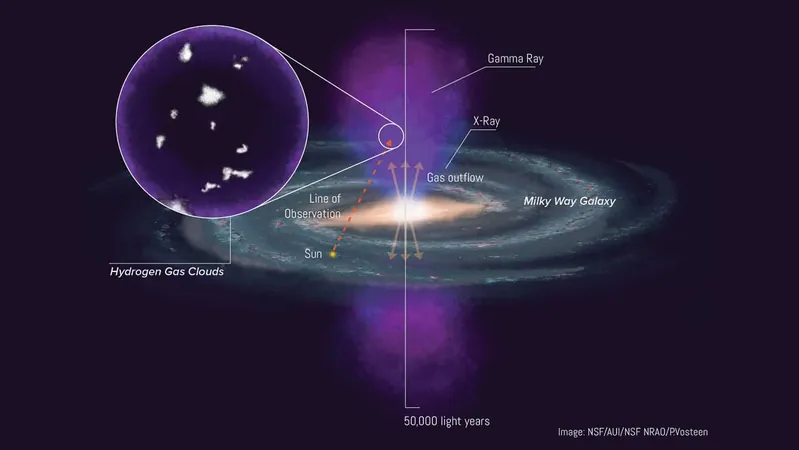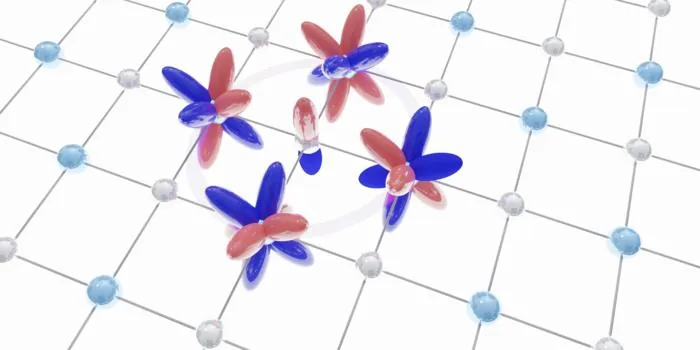
Stunning Discovery: Cold Hydrogen Clouds Unveiled in the Fiery Fermi Bubbles of the Milky Way
2025-07-07
Author: John Tan
Revolutionary Findings at the Heart of Our Galaxy
In an astonishing revelation, researchers have detected cold clouds of hydrogen gas nestled deep within the Fermi bubbles that shroud the center of the Milky Way. This groundbreaking discovery not only redefines our understanding of these massive cosmic structures but also suggests that they are significantly younger than previous estimates proposed.
What Are Fermi Bubbles?
"The Fermi bubbles are colossal formations of hot gas, soaring about 25,000 light years above and below the Milky Way's disk," explains Rongmon Bordoloi, an associate professor of physics at North Carolina State University. These bubbles were first identified in 2010 through gamma-ray observations and are believed to have resulted from a violent, explosive event—akin to a cosmic eruption.
Unveiling New Details Using Cutting-Edge Technology
Utilizing the National Science Foundation's Green Bank Telescope, Bordoloi and his team captured unprecedented high-resolution data about the gas composition and motion within the Fermi bubbles. Their findings indicated that while most of the gas swirls around at a searing 1 million degrees Kelvin, they also stumbled across unexpected, cooler clouds of hydrogen. Each of these dense clouds boasts several thousand solar masses and is located 12,000 light years from the galactic center.
Ice Cubes in a Cosmic Volcano?
"These clouds are around 10,000 degrees Kelvin, making them dramatically cooler than their fiery surroundings—by at least a factor of 100!" comments Andrew Fox, an astronomer at the Space Telescope Science Institute. This scenario is reminiscent of finding ice cubes in the heart of a volcano—an incredible juxtaposition!
Challenging Existing Theories
The presence of these cold clouds is surprising because they would typically be obliterated by the intense heat and high-speed plasma of the Fermi bubbles' environment. Bordoloi points out that theoretical models suggest cool gas should be erased within a few million years, aligning with previous estimates that suggested these bubbles could be much older.
A Cosmic Connection
Further supporting their findings, the researchers linked these cold clouds to observations made by the Hubble Space Telescope, which identified various temperatures of highly ionized gas. This correlation hints at a dynamic relationship where the cold gas may be evaporating due to the intense heat of its surroundings.
Speed of Sound in a Cosmic Wind
The researchers also measured the speed of these gas clouds at nearly a million miles per hour. "This confirms that the Fermi bubbles represent a recent phenomenon in cosmic timescales," Bordoloi states, emphasizing that these clouds weren't around during the age of the dinosaurs.
A New Perspective on Galactic Weather Patterns
Jay Lockman from the Green Bank Observatory elaborates, suggesting that these cold clouds may have been lifted from the Milky Way's core by the hot winds responsible for forming the Fermi bubbles. Just as clouds reveal the motion of the wind here on Earth, these cold structures highlight the invisible forces shaping our galaxy.
Implications for Galactic Evolution
This revelation significantly alters our understanding of how cold gas can endure the fierce energy of the Galactic Center, providing essential data for future simulations of galactic feedback and evolution. As scientists delve deeper into these findings, our comprehension of matter and energy cycling through galaxies may undergo a dramatic transformation.



 Brasil (PT)
Brasil (PT)
 Canada (EN)
Canada (EN)
 Chile (ES)
Chile (ES)
 Česko (CS)
Česko (CS)
 대한민국 (KO)
대한민국 (KO)
 España (ES)
España (ES)
 France (FR)
France (FR)
 Hong Kong (EN)
Hong Kong (EN)
 Italia (IT)
Italia (IT)
 日本 (JA)
日本 (JA)
 Magyarország (HU)
Magyarország (HU)
 Norge (NO)
Norge (NO)
 Polska (PL)
Polska (PL)
 Schweiz (DE)
Schweiz (DE)
 Singapore (EN)
Singapore (EN)
 Sverige (SV)
Sverige (SV)
 Suomi (FI)
Suomi (FI)
 Türkiye (TR)
Türkiye (TR)
 الإمارات العربية المتحدة (AR)
الإمارات العربية المتحدة (AR)